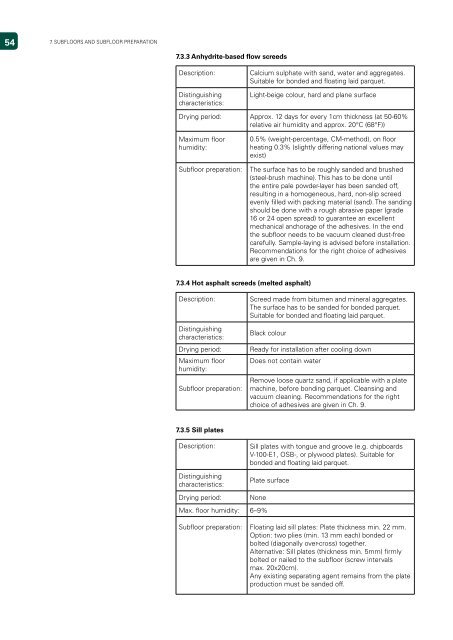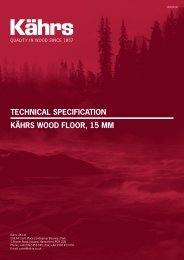Competence.Work Parquet - 1926 Wood Flooring
Competence.Work Parquet - 1926 Wood Flooring
Competence.Work Parquet - 1926 Wood Flooring
You also want an ePaper? Increase the reach of your titles
YUMPU automatically turns print PDFs into web optimized ePapers that Google loves.
5<br />
PARKETT-HANDBUCH<br />
7. SUBFLOORS AND SUBFLOOR PREPARATION<br />
7. . Anhydrite-based flow screeds<br />
Description: Calcium sulphate with sand, water and aggregates.<br />
Suitable for bonded and floating laid parquet.<br />
Distinguishing<br />
characteristics:<br />
Light-beige colour, hard and plane surface<br />
Drying period: Approx. 12 days for every 1cm thickness (at 50-60%<br />
relative air humidity and approx. 20°C (68°F))<br />
Maximum floor<br />
humidity:<br />
0.5% (weight-percentage, CM-method), on floor<br />
heating 0.3% (slightly differing national values may<br />
exist)<br />
Subfloor preparation: The surface has to be roughly sanded and brushed<br />
(steel-brush machine). This has to be done until<br />
the entire pale powder-layer has been sanded off,<br />
resulting in a homogeneous, hard, non-slip screed<br />
evenly filled with packing material (sand). The sanding<br />
should be done with a rough abrasive paper (grade<br />
16 or 24 open spread) to guarantee an excellent<br />
mechanical anchorage of the adhesives. In the end<br />
the subfloor needs to be vacuum cleaned dust-free<br />
carefully. Sample-laying is advised before installation.<br />
Recommendations for the right choice of adhesives<br />
are given in Ch. 9.<br />
7. . Hot asphalt screeds (melted asphalt)<br />
Description: Screed made from bitumen and mineral aggregates.<br />
The surface has to be sanded for bonded parquet.<br />
Suitable for bonded and floating laid parquet.<br />
Distinguishing<br />
characteristics:<br />
Black colour<br />
Drying period: Ready for installation after cooling down<br />
Maximum floor<br />
humidity:<br />
Subfloor preparation:<br />
7. .5 Sill plates<br />
Does not contain water<br />
Remove loose quartz sand, if applicable with a plate<br />
machine, before bonding parquet. Cleansing and<br />
vacuum cleaning. Recommendations for the right<br />
choice of adhesives are given in Ch. 9.<br />
Description: Sill plates with tongue and groove (e.g. chipboards<br />
V-100-E1, OSB-, or plywood plates). Suitable for<br />
bonded and floating laid parquet.<br />
Distinguishing<br />
characteristics:<br />
Drying period: None<br />
Max. floor humidity: 6–9%<br />
Plate surface<br />
Subfloor preparation: Floating laid sill plates: Plate thickness min. 22 mm.<br />
Option: two plies (min. 13 mm each) bonded or<br />
bolted (diagonally over-cross) together.<br />
Alternative: Sill plates (thickness min. 5mm) firmly<br />
bolted or nailed to the subfloor (screw intervals<br />
max. 20x20cm).<br />
Any existing separating agent remains from the plate<br />
production must be sanded off.





